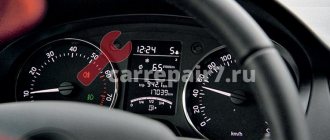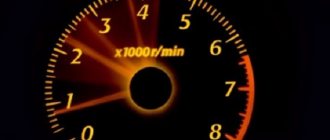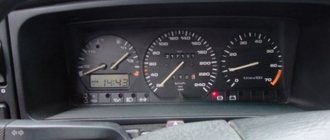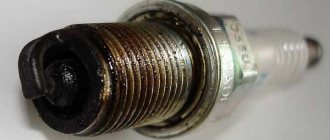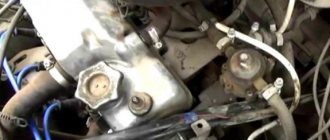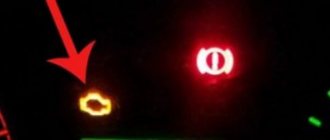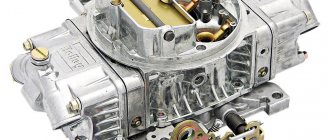A car engine is a very complex mechanism. You begin to understand this especially clearly in moments of failure. There are problems that baffle even specialists. One of these problems is failures when pressing the gas. We studied this problem in detail, determined its nature, established the causes and found solutions. If this problem bothers your car, then you are on the right track with us.
Causes of failures when pressing the gas pedal
The gas (accelerator) pedal is a control with which the driver doses the volume of the combustible mixture, which at that particular moment must enter the engine cylinders in order for the car to drive faster or slower, but several systems are responsible for the ratio of air and fuel (mixture quality) , controlled not by the driver, but by the “brain” of the car (ECU), or mechanics (carburetor).
Gas pedal
In a carburetor engine, this dosing is easier - the cross-section of the main jet opening through which gasoline passes becomes larger or smaller. If necessary, only the idle jet works; when you press the pedal, both work together. Next, the main thing for the engine is to ignite the mixture with a high-quality spark, and the required force to turn the crankshaft will be obtained.
In modern injection engines and diesel engines, changing the position of the gas pedal gives a command, before executing which, the electronic unit “checks” with the readings of pressure and temperature sensors, and with data. showing the speed of the crankshaft and camshafts, the volume of air consumed and the content of residual oxygen in the exhaust gases.
Failure when pressing the gas occurs if:
- Data from one or more sensors is incorrect, missing, or does not match the baseline.
- Electronics has accumulated a large number of critical errors (the dump and flash memory need to be rewritten).
- Something is preventing fuel from reaching the cylinders in full.
- Something makes it difficult for air to fully enter the cylinders.
- Something makes it difficult to evacuate the spent mixture into the exhaust manifold.
- One or more cylinders are misfiring.
- The spark does not ignite at a certain moment - the advance has been lost.
If the car is “old”, it will require comprehensive diagnostics, because the problem can be caused by all these reasons at the same time.
Injectors, intake and exhaust manifolds wear out and become clogged, Hall sensors and explosive wires fail due to age, compression decreases due to wear, springs and hydraulic compensators in the cylinder head get tired, and advance settings “float”. On cars with short mileage (up to 100 thousand km), one unit usually fails. During the runs before the second maintenance, most often a factory defect or a consequence of poor quality assembly “comes out”.
Engine stalls when switching to gas
The presence of gas equipment in a car, along with certain advantages, can cause a number of inconveniences to the driver. One of the common problems is that the engine stalls when switching from gasoline to gas. The problem can manifest itself in different ways. In the first case, the unit stalls immediately, that is, at the moment of transition; in the second, the engine choke after the driver presses the accelerator after the transition, that is, when the engine is already running on gas in idle mode.
In such a situation, it should be taken into account that the gearbox on many gas equipment requires heating to a certain temperature (for example, 35, 40 or 50 degrees Celsius). To save gasoline during warm-up, some drivers and LPG adjusters set a minimum temperature threshold, after which switching occurs. As a result, a switch to gas occurs, the gearbox is still cold and the engine does not have enough fuel.
The reason is that a cold reducer does not evaporate the supplied gas in the required volume. Please note that we should not exclude the fact that the degree of heating of the gearbox depends on the characteristics of its connection (to the manifold, to the heater hoses, etc.), as well as on the level of coolant in the system. Let us add that another common cause may be the gas injectors themselves. In some cases they need to be cleaned, in others it is better to replace them with more efficient ones.
How to understand why failure occurs when you press the accelerator
Often, the source of the problem is indicated by additional signs of a malfunction - for example, a “reluctant” engine start “on cold”, a general decrease in power (even before failures appear), increased fuel consumption. A very important criterion is when the problem manifests itself. If you notice that the engine spins up nonlinearly, as if there is a counterforce preventing it from gaining speed, most likely the reason is a clogged fuel or air filter. If the car “jerks” during acceleration with a smooth opening of the throttle, and, when pressed more intensely, it suddenly “shoots” - the jerks are associated with a lack of fuel. Dips during over-throttle and prolonged pressing and holding of the gas pedal, multiplied by difficult starting of a cold engine, indicate a malfunction of one or more spark plugs (and their coils).
Flooded or faulty spark plugs can also cause the gas pedal to fail.
The spark plugs that come with the car from the factory are more durable than most commercially available consumables, so it is recommended to do the second and subsequent replacements at shorter intervals.
Sometimes the problems of loss of throttle response, jerking, stepwise acceleration during acceleration are not at all related to the operation of the engine. On cars with automatic transmission, this is how severe wear appears. You will notice it when switching during acceleration - first a second delay without reaction to the gas pedal, then a push and acceleration. In cars with gas equipment, such a reaction to gas begins to occur when the gas reducer or its sensor breaks down. At the same time, the car begins to consume two to three times more gas. In diesel engines, an adequate response to vigorous pressing of the gas pedal is greatly impaired by refueling with low-quality fuel with a high sulfur content, or with a type of diesel fuel that does not correspond to the season.
How problems manifest themselves
Failure is a lack of response, an unexpected disturbance that appears in the operation of the motor. Occurs periodically in different modes, not only during sharp, but also smooth operation of the accelerator. At the same time, acceleration decreases and stops are possible.
How interruptions manifest themselves:
- short - no reaction for up to 2-3 seconds;
- deep - loss of speed occurs over a period of 3 to 10 seconds, stopping is possible;
- jerks – last up to 2 seconds;
- twitching - represented by a series of jerks when the car either develops or loses speed without changing the position of the accelerator;
- rocking - multiple interruptions, reminiscent of twitching, lasting about 4 seconds.
Experts note that the main cause of such problems is over-enrichment or over-leanness of the air-fuel mixture. This helps to diagnose and find the cause.
Gaps during acceleration
When accelerating a car, the load on the engine increases, which requires more fuel-air mixture, so most problems that cause failure during acceleration are associated with a lack of fuel or air. Check the condition of the fuel pump, filters, rail pressure, spark quality (in a gasoline engine). Changing the settings - mixture quality and ignition timing - is controlled by the electronics, so it is better to start diagnosing the problem by checking the dynamic indicators with a scanner directly during the trip.
Remember: if your car is equipped with an electronic “E-gas” pedal, there are usually three reasons that cause “failure” when you press it: shorted contacts, failure of the clutch and brake position sensor, or a system error.
When you press the gas pedal hard, used cars often experience a delay in the opening of the intake manifold flaps. This is a purely mechanical problem when, due to age and vigorous use, the collector becomes overgrown from the inside with a thick layer of soot “spitted out” by the cylinders of oil (and soot from the USR). The swirl flaps in the intake manifold can be cleaned or removed, just like the USR valve, but this must be done physically and programmatically, in a certified service center.
Why doesn't the engine rev up? Possible causes and methods of eliminating them
Lack of engine speed when pressing the gas pedal is a common problem that most drivers have encountered. There are many reasons for this unpleasant situation: it can be either a transition from a gasoline engine to gas-cylinder equipment, or a simple engine malfunction. Let's study the reasons in more detail.
The engine does not pick up speed when you press the gas pedal: reasons
First of all, you need to pay attention to the “symptoms” of the problem: when it manifests itself, how, and whether there are additional signals indicating a malfunction. It is quite possible that the engine is fully operational and is being prevented from functioning normally by a sensor that was disconnected during repairs. The technician can fix this problem after a short inspection.
If engine failures occur without any serious reasons, careful diagnostics are required.
Let's take a closer look at the reasons that the car owner can correct himself.
A key factor in reliable engine operation is the quality of the fuel mixture, the characteristics of its flow, ignition and combustion in the working area of the engine. Violation of any of the above processes leads to problems with engine speed. That is why, in case of failures in the internal combustion engine, the first thing you should pay attention to is the operation of the fuel and oxygen supply system.
- If dirt, a mixture of oil and sand has accumulated in the air filter, air will penetrate into the engine unevenly, which will lead to a loss of engine power and, accordingly, to “missed” revolutions.
2. Malfunction of the intake system leads to excessive air leaks. The failure may occur suddenly, or it may become chronic. The intake of a large amount of air depletes the mixture, and there are too few flammable vapors in it. In this case, the engine starts, but during the trip the car cannot reach the required speed.
3. Lack of fuel in the engine. This problem most often occurs due to a clogged filter. There is enough fuel to start the engine, but it is no longer enough for normal driving. As a result, the car jerks and does not respond well to the gas pedal. During the increase in speed, so-called “dips” are observed.
4. Accumulation of dirt on the fuel pump filter. The filter is a small mesh; when oily deposits get on it, the pressure in the system increases and a sufficient amount of fuel does not enter the combustion chamber. When the fuel pump filter becomes dirty, the engine begins to operate intermittently in almost all modes. When trying to gain speed, the internal combustion engine may simply stall.
5. Problems with spark plugs or electrical wiring, leading to problems with ignition of the combustible mixture. In this case, the fuel ignites at the wrong time, the engine loses power, and the system is unable to gain speed. The spark plugs may become oily and dirt may accumulate on them. Common causes of spark plug malfunctions include damage to the casing and incorrect setting of the electrode gaps.
6. Breakage of electrical wires connected to the spark plugs. In this case, the engine troits, and the engine gains speed with great reluctance.
Correcting these problems is not difficult: you need to check whether the spark plugs and wires are sparking; look at the pressure level on the fuel rail pressure gauge; remove oily deposits and dirt from the air filter; change the fuel filter to a new one; clean the fuel pump screen, etc. from dirt deposits.
Engine speed may also drop for more complex reasons, which cannot be eliminated on your own, since repairs require special knowledge, experience and the availability of diagnostic equipment.
%rtb-4%
You cannot do without the help of a car service if:
- Failure in the timing of the car's gas distribution mechanism. If the timing of the engine is disrupted, the fuel intake and exhaust gases are uneven, and the valves open intermittently. A similar problem often arises after poor-quality repairs such as replacing the timing belt, improper valve adjustment, malfunctions of the valve timing system, and failure of the timing chain.
- Malfunction of the coils or ignition module. The main “sign” of this problem is that the engine begins to stall, misfires are observed in the cylinder system, and the number of revolutions decreases.
- Malfunctions in the power supply of the injector nozzles. The most common cause of this problem is poor wiring. The electrical signal does not reach the injector or does not reach it at the right time. Naturally, under such conditions, the injector cannot work correctly, which is why the fuel ignites unevenly in the cylinders, and engine power drops along with the speed.
- Problems with the fuel pump. An unpleasant breakdown that develops slowly but inevitably. As a result, the pressure created will not be enough to operate the engine: the engine will stall.
- Dirt getting into the injector. This problem can be caused by the use of low-quality fuel and contamination of the injectors. It is recommended to clean the injectors after 35-45 thousand km. mileage
- Unsatisfactory condition of the systems responsible for the removal of gases, primarily the USR, soot filters and catalyst. A large amount of carbon dioxide remains in the engine and the engine is not able to gain the required number of revolutions under such conditions.
- Failure of the electronic control system devices of the internal combustion engine, leading to a change in the composition of the combustible mixture.
- A breakdown of the electronic control unit cannot be ruled out. This problem can occur after poor-quality firmware repair. The main signal of a problem in the ECU is the jerky operation of the engine, an unexpected increase and drop in torque.
Timely implementation of simple service procedures such as cleaning the injector, replacing spark plugs or filters is an excellent prevention of any engine problems.
For a gas car, the correct settings of the engine and fuel supply system are key.
What to do if the engine stalls at idle
Share on Facebook Share
Share on TwitterTweet
Share on Google Plus Share
Share on Pinterest Share
Share on LinkedIn Share
Share on Digg Share
Dips at idle
If the revolutions drop not when you press the gas pedal, but on their own - in the interval between starting the engine and completely warming up, you will need a good scanner to fully diagnose the cause. A problem that appears only on a cold or only on a hot engine may simply be a failure of electronic components. Among the sensors, the “champions” in terms of failures were: “brains” (control electronics unit), throttle position sensor, idle air control, intake air pressure and temperature sensors, flow meter.
Errors in the ECU are most often the cause of the gas pedal failing
Not all inconsistencies in indicators, loss of sensor signals, or open circuits cause errors on the instrument panel. Most pass without a trace, and only an experienced diagnostician will see them in the logs.
You can independently check for external air leaks, replace the air and fuel filters, change spark plugs, high-voltage wires, and coils. Measure compression in all cylinders. Inspect the engine head for oil leaks from under the crankcase ventilation valve - it may be clogged and will need to be washed or replaced. If you are not sure about the cleanliness of the tank and the quality of the fuel, drain it completely by washing the tank and the fuel pump sump.
Popular brands:
Renault Logan
Why does the car jerk when you gently press the accelerator?
- In this situation, the engine responds late to pressing the gas pedal. Jerking occurs when the throttle valve remains open for a long time. At the time of acceleration, the throttle position sensor (TPS) must send a signal to the electronic control unit (ECU) that the engine is switching from idle to load mode, therefore, more fuel must be supplied to the combustion chambers, and the total pressure in the fuel rail must be high. If the TPS is faulty, it does not send the above signal to the ECU (or it does, but with a delay). As a result, the pressure in the ramp drops, the engine begins to twitch, and sometimes stalls. This malfunction occurs in injection engines, both in domestic cars (Lada Priora, Lada Granta) and in foreign cars (in particular, Ford Focus 2). The solution is obvious: you need to replace the faulty sensor.
- The same problem in fuel-injected cars can be created by the mass air flow sensor (MAF). He monitors the formation of the mixture and how much air enters it. If it is faulty, the car will start to twitch before it has time to accelerate. This means that the mass air flow sensor should also be replaced.
- In carburetor cars (VAZ 2107, the first rare release of the VAZ 2114), jerks during acceleration occur due to clogging of the outlet holes in the first carburetor chamber. Solution: the carburetor is removed and blown out with compressed air.
- In classic VAZ models, carburetor accelerator pumps often fail, and this also causes jerking when trying to move away. It is impractical to repair this part, so it should be replaced.
Drop in speed on a carburetor engine
For carburetor engines, dips and jerks when pressing the pedal more than a third of the way indicate that the mixture quality has gone wrong, or the main fuel jet is clogged. In addition to reducing the gasoline content in the mixture, the quality is affected by an increase in incoming air, so check the integrity of the gasket under the carburetor and the intake manifold body itself after the air filter. Wash the carburetor, check if condensation has accumulated in the sump, replace the air and fuel filters. You can also replace spark plugs, high-voltage wires and coils yourself. Change components one at a time, checking what happens when you sharply press the gas pedal.
High-voltage wires, ignition coils and spark plugs must be changed sequentially
Common causes of engine jerking
As a rule, engine malfunctions (engine tripping, misfires, etc.) are often the reason that the power unit does not respond in a timely manner to pressing the gas pedal, after which jerking appears. This problem affects diesel and gasoline engines, injection and carburetor. Among the various elements to be checked, as well as diagnostic methods and techniques, experts highlight many items. Let's focus on the main ones.
- Oxygen sensor, which is checked with a multimeter. If a malfunction is detected, the element needs to be replaced with a new one or a known good one.
- It should also be remembered that the engine's valve timing may be disrupted. In this case, it is necessary to align the timing belt or chain as accurately as possible according to the marks.
- The stability of engine operation is also greatly influenced by the correct selection of spark plugs. To put it simply, candles differ in their heat rating. In cases where this indicator is not suitable for the engine, the spark plugs may be too cold or hot. As a result, ignition problems arise and engine misfire or engine detonation may occur.
- As mentioned above, the cause of jerking may be injection nozzles that need to be cleaned. You can clean the nozzles and wash the injector yourself, but it is recommended to do this on a stand or wash the injector with ultrasound.
- On a car with a carburetor, jerking when you sharply press the gas appears in cases where the carburetor accelerator pump stops working correctly. In this case, the pump must be removed and its nozzle, diaphragm, channels, etc. inspected. If clogged, it must be cleaned.
Drop in injector speed
The characteristic “thoughtfulness” when vigorously pressing the gas pedal indicates incorrect operation of the injectors or fuel pump. You can check whether the quality and volume of the mixture your car “feeds” corresponds to the standard through detailed diagnostics. Separately, you need to remove the injectors and check their performance on a bench.
It’s easier to look for the cause in a sequence from simple to complex: change the fuel, flush the tank, replace the filters, check the pump mesh in the tank and the pressure in the rail, then test the injectors.
Some injectors can be restored, others will have to be replaced, correctly registering the replacement in the “brains”. Difficulties during acceleration can also be a sign of a malfunction of the electronic unit that controls the injection system. If it cannot be eliminated by chipping, the “brains” will have to be changed.
Checking the carburetor system
Initially, the operation of the fuel system is checked to see how smoothly and correctly it works. Every working unit and detail matters. Air leaks are checked, fuel lines are examined and the fuel pump is diagnosed. All blockages and deposits are removed.
Fuel pump If the diagnostics do not reveal any problems, then the carburetor may cause a failure in the engine when the gas pedal is pressed. This part is responsible for supplying fuel. During normal operation of the carburetor, fuel is supplied without interruption, constantly and evenly.
To identify and eliminate the cause of the problem, you must proceed as follows:
- We exclude air leaks, which may occur due to a loose fastening on the exhaust manifold.
- We study the condition of the mesh-type filter, which is located in the area where the pipe from the fuel pump connects.
- We dismantle the EPH valve and the sealing ring and examine their condition. If the EPHH is working properly, then when you connect one side of the wire to the terminal, and the opposite end to the positive terminal of the battery, a clicking sound will be heard.
- Check the liquid level in the float chamber. To do this, start the engine, leave it to run for a while, remove the top carburetor cover and filter housing. Now let's evaluate the fuel level. In normal condition, it should be in the middle of the inclined wall.
- The dosing system may become clogged and this is a common problem. To eliminate it, you will need to remove the top part of the dispenser and the jets. We look for blockages and remove them using wooden parts. Emulsion tubes, which are often forgotten, also need inspection and maintenance.
- Special products are used to clean the carburetor channels.
Mechanical failures of the gas pedal
A separate category of breakdowns is when, when you press the pedal, your foot feels a very specific dip until it clicks, after which the part does not return to its original position, and the car, paradoxically, does not react to this (either sharply or smoothly, repeatedly pressing the pedal) . The pedal fails mechanically for only one reason - the problem is a burst seal (rubber or plastic), or the cable sheath stops on the gas drive. Sometimes the cable itself breaks, but mostly you have to change the stops and seals. In winter, failure is caused by freezing of condensate in the cable sheath.
Eliminating such pedal failures is quite possible to do yourself if you know exactly the appearance, position and number of the broken part. The most difficult thing is to change a broken throttle cable, so if you are not confident in your abilities, or simply do not want to waste time, it is better to involve specialists. Contact a trusted car service center.
RPM failure
A drop in speed is manifested by the lack of engine response to the pressed gas pedal. When the driver tries to pick up speed, the car does not react at all, or does it too late. This manifests itself as follows.
- A short dip lasting 3-5 seconds. But this is enough to create a dangerous situation on the road.
- Prolonged lack of response. Up to ten seconds, sometimes more. The car has every chance of stalling.
- Jerks with jerking. Duration - about two seconds.
- Numerous consecutive jerks. The engine operates differently when the gas pedal is in one position.
- A series of deep failures. The car is shaking seriously.
Triple
This is the most common phenomenon that every vehicle owner, and even novice drivers, knows about. However, not everyone understands what exactly this term means. When experts talk about engine tripping, they mean that one cylinder (or several) is not functioning. The result is failure of the gas pedal. Moreover, this phenomenon negatively affects the power unit itself.
And if experienced drivers are able to easily identify the signs of tripping by ear, then beginners should rely on the following symptoms:
- Even at low crankshaft speeds, the car began to accelerate more slowly.
- The power plant begins to shake.
- Fuel consumption increases.
- Darkening is noticeable on one spark plug or several products.
It is not difficult to determine in which cylinder the spark plug is not working (if the problem is in it) - you need to disconnect the high-voltage wire one by one, and then increase the speed to 1,500 each time. If the sound of the running engine does not change, it means that the “good” cylinder has been turned off, you should switch to the next one.
Drivers who independently disconnect high-voltage wires must exercise extreme caution, as there is a risk of electric shock. Often the contacts become oxidized and, as a result, no current flows. You can diagnose this problem with a multimeter.
